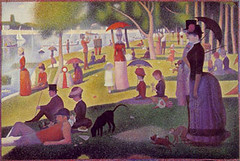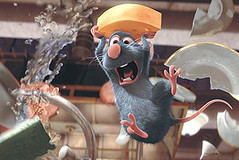Please bear with me here. I'm about to try to connect some things that maybe don't deserve to be connected, except in that they all interest me.
Like a lot of middle school and high school girls (at least back in the late 80s and mid-90s, when I was in school), I have an unshakable soft spot for most hazily drawn paintings created in France at the end of the 19th century. I'm not saying that my house is plastered in water lilies calendars - AT ALL - but I also can't say that seeing Monet's real Rouen Cathedral paintings didn't take my breath away.
On top of that (and this is related), I've always been more into Ferris than Lloyd (if you're my age, you might have to choose. For girls today, it's all about Jim.) The famous Grande Jatte scene at the Art Institute of Chicago just kills me.
This is a long way of saying that I couldn't possibly ignore Slate's slideshow discussion of the Seurat drawing exhibit at the MOMA. It's a fascinating - and short - article about Seurat's skill and the mystery of his politics.
As a wannabe art historian, I am naturally obsessed with the way that politics intertwines with art, though sometimes I also like to look for the cultural strains that are less overtly woven into artistic expression. For example, my pet project in college involved the Jean Francois Millet painting The Sower. In classes, it was used as an example of the Realist style of the Barbizon school of artists (mid-19th century Paris). My favorite paper I wrote in college was about how Millet wove elements of the (polar-opposite of Realist) Romantic into this Realist work.
And here is how I'm going to make this about food:
The Slate article quotes Seurat's contemporary, art critic/anarchist Felix Feneon, using a scientific explanation to describe the pointilist magic of La Grande Jatte. Feneon refers to colors that are "isolated on the canvas", but that "recombine on the retina." Seurat, according to Feneon, has injected science into art in a manner that's both revolutionary and aesthetically amazing.
And I thought of Marcel. Which is terrible, because I really should've first thought of like Ferran Adria or Wylie Dufresne or somebody who was a little more of a pioneer in the science of food and flavor. Or of Thomas Keller, who deconstructs meals and recreates them in unexpected ways. But Top Chef permeates my brain and I thought of Marcel, but that doesn't change the overall connection: food artists inject science into their creations for the same reasons and, when successful, with similar (if less enduring) results as Seurat's pointilist masterpiece.
From there, I thought back to my thesis on The Sower - that in infusing his painting with elements of the Romantic, Millet didn't dilute the harsh reality of his subject. But he did make it easier for the audience to connect to the work.
The same happens in food. All the time. Thomas Keller's sophisticated ratatouille that gives the movie it's name is deconstructed, reconstructed, fancy but made with simple, rustic ingredients - and its flavor evokes memory and that's why it's most successful as a dish. It's romantic and scientific and realistic all at once.
I'm not sure if I'm any closer to illustrating a real connection between movements in art and movements in food. But I do think that I've come to an end of my rambling.
And I will definitely spend the rest of the day trying to infuse whatever I make for dinner tonight with layers of underlying theory and meaning. Cooper is the luckiest man EVER.
Thursday, November 01, 2007
Dots and Food and Romance
Subscribe to:
Post Comments (Atom)



No comments:
Post a Comment